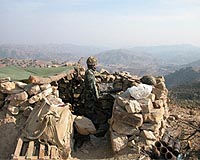| . |  |
. |
Washington (AFP) June 20, 2009 A failure by US forces to follow procedures in air strikes last month in Afghanistan "likely" caused the death of at least 26 civilians, the US military said. An internal investigation of a May 4 battle with Taliban insurgents in western Afghanistan found US air crews and ground troops acted in line with the laws of armed conflict but three air strikes by a B-1 bomber failed to adhere to US combat rules and orders. "Not applying all of that guidance likely resulted in civilian casualties," said a summary of the military probe released Friday. The report recommended tactics and combat rules in the Afghan war be revised to avoid civilian casualties but did not call for prosecution of any US military personnel. The investigation found that 78 Taliban fighters were killed and 26 civilians died in the incident, but said it was possible that a higher number of civilians were killed. The Kabul government has put the civilian toll at 140. The incident has fueled public anger at the NATO-led coalition and prompted President Hamid Karzai to demand a halt in air strikes. US and NATO officials have grown increasingly concerned about the effect of civilian casualities on the war effort, as insurgents have sought to exploit the incidents to sow distrust of foreign troops. The new American commander in Afghanistan, General Stanley McChrystal, has ordered a 60-day review of the entire military mission to identify better ways to separate the population from insurgents, The New York Times reported Saturday. "The measure of effectiveness will not be enemy killed," the newspaper quoted the commander as saying. "It will be the number of Afghans shielded from violence." The report, issued by US Central Command, described an intense battle over several hours with Afghan security forces calling for assistance from a team of US Marines near the village of Gerani in the Farah province. The Marines had tried to persuade Afghan authorities to hold off on moving against about 300 Taliban that had threatened local villagers, suggesting more time was needed to fully plan an operation, it said. But the Afghan security forces went ahead and soon had to call the Marines for assistance. Scrambling to rescue Afghan forces pinned down by insurgent gunfire and secure the evacuation of wounded soldiers, the Marines called in air power. A first wave of strikes by F/A-18 fighter jets hit intended targets apparently without causing civilian casualties, according to the report. After nightfall, a B-1 Lancer bomber was called in to relieve the F/A-18s and carried out three strikes using 500-pound and 2,000-pound bombs. In two of the three raids, the bombing likely caused civilian deaths, the report said. In both cases, air crews and the ground commander believed they were targeting insurgent forces in buildings based on intelligence reports, even though the groups of adults they targeted in the darkness had not fired on them. Neither the ground force commander or the bomber crew "could confirm the presence or absence of civilians already in the building," the report said. In the third strike, the crew of the bomber and ground commander spotted a group of adults that they suspected were Taliban forces "moving rapidly in the dark across difficult terrain in an evenly-spaced formation." The ground commander ordered the B-1 bomber to hit a building where he believed the insurgents had moved. The aircraft then dropped a 2,000-pound bomb on the target. "The inability to discern the presence of civilians and assess the potential collateral damage of those strikes is inconsistent with the US government's objective of providing security and safety for the Afghan people," the report said. The incident and varying US accounts of what transpired has illustrated the difficulties faced by the NATO-led force as it tries to fight insurgents, protect its troops and win over the Afghan population. In a series of recommendations, the investigation said it was vital for the US and coalition mission in Afghanistan to adopt tactics that put a priority on avoiding civilian casualties. The probe called for combat rules and tactics -- including the use of air power and the scale of lethal force -- to be refined and troops to be trained under the new guidance. It urged more timely public relations efforts in cooperation with Kabul ministries to better communicate with the Afghan people and to ensure the coalition is "first with the truth." Share This Article With Planet Earth
Related Links News From Across The Stans
 Pakistani jets bomb Taliban's tribal hideouts: officials
Pakistani jets bomb Taliban's tribal hideouts: officialsPeshawar, Pakistan (AFP) June 19, 2009 Pakistani fighter jets Friday bombed Taliban militant hideouts in the northwest tribal belt, officials said, as the death toll from a suspected US missile strike in the area rose to 13. Up to three unmanned drone aircraft are reported to have dropped four missiles on a training school for Islamist extremists in the lawless South Waziristan tribal zone near the Afghan border Thursday. ... read more |
|
| The content herein, unless otherwise known to be public domain, are Copyright 1995-2009 - SpaceDaily. AFP and UPI Wire Stories are copyright Agence France-Presse and United Press International. ESA Portal Reports are copyright European Space Agency. All NASA sourced material is public domain. Additional copyrights may apply in whole or part to other bona fide parties. Advertising does not imply endorsement,agreement or approval of any opinions, statements or information provided by SpaceDaily on any Web page published or hosted by SpaceDaily. Privacy Statement |